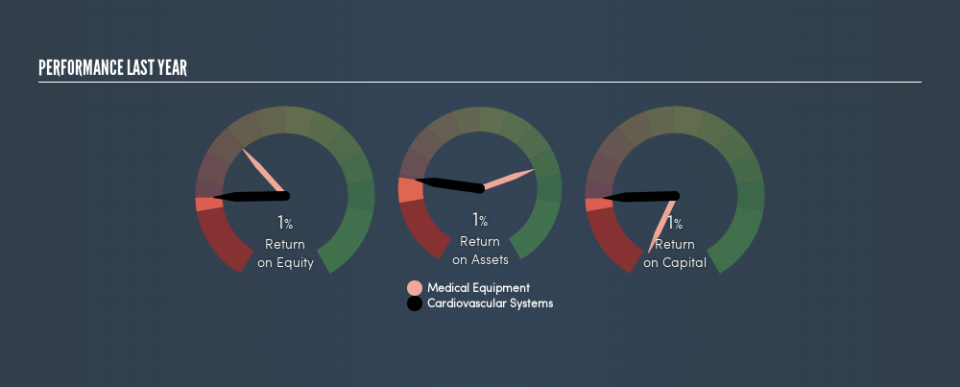Here’s why Cardiovascular Systems, Inc.’s (NASDAQ:CSII) Returns On Capital Matters So Much

Today we are going to look at Cardiovascular Systems, Inc. (NASDAQ:CSII) to see whether it might be an attractive investment prospect. To be precise, we'll consider its Return On Capital Employed (ROCE), as that will inform our view of the quality of the business.
First, we'll go over how we calculate ROCE. Next, we'll compare it to others in its industry. Then we'll determine how its current liabilities are affecting its ROCE.
Return On Capital Employed (ROCE): What is it?
ROCE is a measure of a company's yearly pre-tax profit (its return), relative to the capital employed in the business. Generally speaking a higher ROCE is better. Overall, it is a valuable metric that has its flaws. Renowned investment researcher Michael Mauboussin has suggested that a high ROCE can indicate that 'one dollar invested in the company generates value of more than one dollar'.
How Do You Calculate Return On Capital Employed?
Analysts use this formula to calculate return on capital employed:
Return on Capital Employed = Earnings Before Interest and Tax (EBIT) ÷ (Total Assets - Current Liabilities)
Or for Cardiovascular Systems:
0.0099 = US$1.7m ÷ (US$211m - US$40m) (Based on the trailing twelve months to March 2019.)
Therefore, Cardiovascular Systems has an ROCE of 1.0%.
See our latest analysis for Cardiovascular Systems
Is Cardiovascular Systems's ROCE Good?
ROCE can be useful when making comparisons, such as between similar companies. Using our data, Cardiovascular Systems's ROCE appears to be significantly below the 10% average in the Medical Equipment industry. This could be seen as a negative, as it suggests some competitors may be employing their capital more efficiently. Putting aside Cardiovascular Systems's performance relative to its industry, its ROCE in absolute terms is poor - considering the risk of owning stocks compared to government bonds. There are potentially more appealing investments elsewhere.
Cardiovascular Systems delivered an ROCE of 1.0%, which is better than 3 years ago, as was making losses back then. That implies the business has been improving. You can click on the image below to see (in greater detail) how Cardiovascular Systems's past growth compares to other companies.
Remember that this metric is backwards looking - it shows what has happened in the past, and does not accurately predict the future. ROCE can be deceptive for cyclical businesses, as returns can look incredible in boom times, and terribly low in downturns. ROCE is only a point-in-time measure. What happens in the future is pretty important for investors, so we have prepared a free report on analyst forecasts for Cardiovascular Systems.
Cardiovascular Systems's Current Liabilities And Their Impact On Its ROCE
Short term (or current) liabilities, are things like supplier invoices, overdrafts, or tax bills that need to be paid within 12 months. The ROCE equation subtracts current liabilities from capital employed, so a company with a lot of current liabilities appears to have less capital employed, and a higher ROCE than otherwise. To counter this, investors can check if a company has high current liabilities relative to total assets.
Cardiovascular Systems has total liabilities of US$40m and total assets of US$211m. Therefore its current liabilities are equivalent to approximately 19% of its total assets. This is a modest level of current liabilities, which will have a limited impact on the ROCE.
Our Take On Cardiovascular Systems's ROCE
Cardiovascular Systems has a poor ROCE, and there may be better investment prospects out there. But note: make sure you look for a great company, not just the first idea you come across. So take a peek at this free list of interesting companies with strong recent earnings growth (and a P/E ratio below 20).
For those who like to find winning investments this free list of growing companies with recent insider purchasing, could be just the ticket.
We aim to bring you long-term focused research analysis driven by fundamental data. Note that our analysis may not factor in the latest price-sensitive company announcements or qualitative material.
If you spot an error that warrants correction, please contact the editor at editorial-team@simplywallst.com. This article by Simply Wall St is general in nature. It does not constitute a recommendation to buy or sell any stock, and does not take account of your objectives, or your financial situation. Simply Wall St has no position in the stocks mentioned. Thank you for reading.

 Yahoo Finance
Yahoo Finance 
